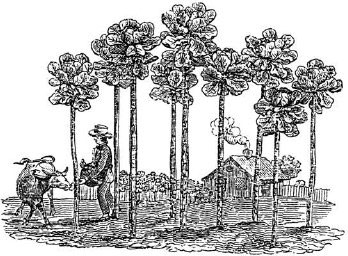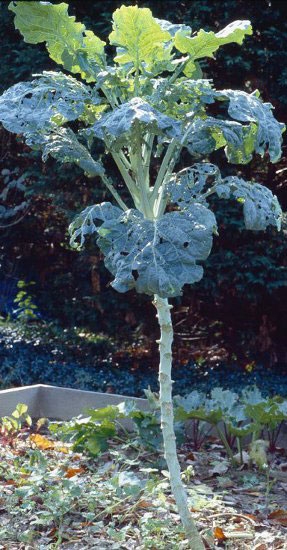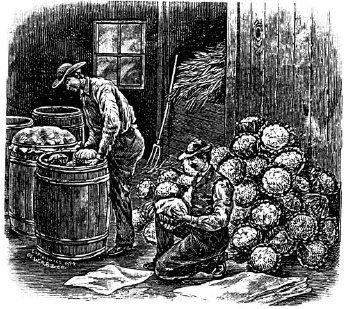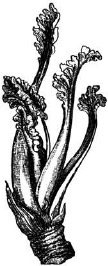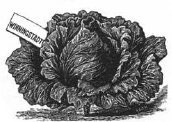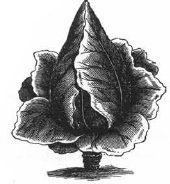May 15, 2013
Brassica oleracea var. acephala
Perhaps my partiality for this unusual cabbage stems from the fact that it is the first cabbage I ever grew. Back in the early 1970s, I obtained seed from J. Stevens Cox of St. Peter Port on the island of Guernsey in response to a little pamphlet he sent me outlining the history of the cabbage. I was naive enough at the time to imagine that I was one of the first to grow it in this country. In fact, it has been grown here off and on since the 1840s. Yet I will say that growing the cabbage made me keenly aware for the first time that there was truly such a thing as an heirloom vegetable outside my own world of Pennsylvania. In one hand I had a packet of seeds, in the other a monograph providing its pedigree. My expectations of the cabbage were not disappointed either, for purely by luck, I planted it in the spring prior to one of the mildest winters on record. It overwintered in the ground, and by the time it blossomed the following June, I had a forest of cabbages nearly 16 feet tall. The neighbors were impressed.
One of the earliest American references to this cabbage surfaced in 1841, when seed was sent from France to a Mr. Page, then postmaster of Philadelphia. He shared seed with several interested gardeners who agreed to trial it. It overwintered and flowered, but only grew 2 feet tall, much to their disappointment. I suspect that Page’s seed was misidentified. It was probably the Sarthe Cow Cabbage (chou fourrager de la Sarthe), a related variety that is much shorter in height.
Parker and Cox (1970) outlined the general history of the cabbage in their monograph. The cabbage was introduced into England in 1827 when the comte de Puysage sent seed from La Vendée, and the seed was divided among six horticulturists, who then trialed it. In their original habitat the cabbages grow from 12 to 20 feet tall owing to the mildness of the climate. Elsewhere, they generally grow only half that size. The cabbage was initially introduced with the idea of promoting it as a fodder crop because as the plant grows, the bottom leaves are pulled off and fed to cows. Sixty plants were considered sufficient fodder for one cow over the course of three or four years. By pulling off the lower leaves, the plant is encouraged to grow upward, which is how it is made to attain such heights. James J. H. Gregory of Marblehead, Massachusetts, advertised seed for the cabbage in the American Agriculturist (February 1868, 73) specifically as a fodder crop for cattle. Victorian gardeners did not consider it dignified food for humans, but prior to that age of overwrought sensibilities, humans did indeed eat it.
The young leaves are quite tender and can be cooked like collards. In the spring, the stalks send off side shoots that are particularly tender. On the islands of Jersey and Guernsey, farmers make a stew with it called soup à choux or soupe à la graisse, which is composed of the cabbage, a piece of slab bacon, and potatoes. Parsnips or turnips sometimes take the place of the potatoes. The cow cabbage makes a good stewing cabbage, and the heart or small leaf head at the top is by far the most delicate part.
It is known today that this type of cabbage is quite ancient, similar in many ways to the cabbages grown by the Celtic peoples residing on both shores of the English Channel. Furthermore, this coastal region lies at the center of the genetic home of all the cabbages of the oleracea species. The farmers on the Channel Islands even used the long, woody stalks as purlins in the roofs of their cottages. Around these they tied their thatch, a practice dating from Roman times and confirmed by archaeology. The ancient Gauls and Britons also baked hearth breads by wrapping them in the large leaves. Jersey Cow Cabbage is excellent for this application; I have experimented with it many times.
Only on rare occasions have I had the cabbage overwinter in the open. Our winters are usually too severe for this. Gardeners wishing to overwinter it for seed purposes will succeed if the plants are dug up in the early fall—select six to eight of the best—and potted. They can be overwintered in a cool shed. As long as the stems do not freeze and are kept alive, the plants will push new growth in the spring. It is not necessary to worry about leaves that may drop off over the winter; rather, it is better that the plants be held in a dormant state. Once replanted in the spring, the stems will revive. It is normal for this cabbage to attain its maximum height the second year and then flower in the third. This may mean that some gardeners will want to raise it exclusively in tubs rather than dig it up two years running. The seed pods are attractive to birds and may need protection under netting in order to properly dry on the plants. Do not throw away the stems when the plants die. They are tough and, when seasoned and dried, make excellent walking sticks. Craftsmen on the Channel Islands still turn out walking sticks for the tourists. If this sounds like too much work, then at least use the stems for bean poles; they are much sturdier than most bamboos.
Brassica oleracea var. botrytis
With so many farmers raising first-rate cauliflower only a few miles away from where I live, I thought I had no incentive to grow it. However, the unusual varieties show up only rarely at market, and the heirlooms not at all. If I want something different, I must grow it myself and out of this necessity (or perverse desire) I have undertaken to raise a number of cauliflowers. Long ago, the American Garden (1889, 58) remarked that “cauliflower is not an easy success.” As much as I would like to see heirloom varieties preserved, I cannot see much future for the old varieties of cauliflower. The plant is too demanding of labor. It thrives in wet, heavy soil and needs constant watering during hot weather. In order to obtain beautiful heads, the plants must be tied up as shown in the old woodcut. This requires a commitment to hand labor that is not profitable unless carried out on a large scale. In the nineteenth century, Suffolk County on Long Island was well known as the “Cauliflower County,” and from there the very best cauliflowers grown in this country originated. Today, the low price of California cauliflower on the open market is largely due to the fact that it has come to us soaked in chemicals that have allowed the producers to shortcut the old cultural methods. Cauliflower was a vegetable created by hands. It was a vegetable luxury, like a fine piece of furniture, or a hand-woven cloak.
A number of heirloom cauliflowers are still extant, but not too many of them are generally available. I think that Purple Cape, developed in South Africa in the eighteenth century, or perhaps even earlier, is one of those old varieties that may be counted on to yield crops with exquisite flavor. The variety first surfaced in 1808, when it was introduced into England from South Africa by Marmaduke Dawnay, who first cultivated it in Surrey. Seeds procured in Italy produced the same variety; so there is an argument as to where it originally evolved. George Lindley mentioned it in his 1831 garden book, and in 1843 it is listed among the new cauliflowers recently introduced into this country in Charles Hovey’s Magazine of Horticulture (9:98). Do not forget that it was competing at the time with Metcalf’s New Pink, Large Wakefield, and Hyatt’s Cream. None of these have survived the test of time with grace. We will leave off discussion of Green Cape and Early Purple, since these varieties surfaced like bubbles on the lake of good eating, only to disappear before chefs had an adequate time to record their glories.
I prefer to recommend Purple Cape because it is hardier than the rest, and I am not embarrassed by its unusual shade. Soil usually determines the final color, but white it is not. I would call it a greenish bronze-purple, shifting to rose, most of which fades when cooked. It does not cook a clear white, hardly a problem when mixed with other ingredients, but this lack of bleached whiteness was viewed years ago as a mark against it, since everything had to look good in béchamel. For the aficionados of white-white cauliflower, allow me to suggest Boston Market, a strain of the French variety called Half Early Paris (chou-fleur demi-dur de Paris). It may seem amusing today, but in the 1840s many American gardeners had no idea what a cauliflower was, let alone how to grow one. Robert Buist was obliged to describe it in his Family Kitchen Gardener (1858, 44) as having “a white head, very similar to a basin rounded full of the curd which is commonly called Cottage Cheese.”
Cauliflowers were grown by wealthy Americans during the early nineteenth century, and to them we owe its cultivation in this country. Gregory Lee, gardener to C. J. Wolbert, Esquire, of Frankford (now part of Philadelphia) wrote an article on his technique for raising cauliflowers that appeared in the New Genesee Farmer (1840, 9). Essentially, Lee planted seed broadcast in September, moved the best seedlings to a cold frame in October, and the following April planted them in the garden. By the end of May he began harvesting cauliflowers twice the size of those grown for fall harvesting. His technique works. It works brilliantly in my climate, but it is also labor intensive, and I am not convinced that it is economical. Perhaps that was the point entirely, for in old cookbooks, those whole heads of poached cauliflower brought to table with much fanfare were implicit metaphors of luxury. Most of the foods we eat today have lost this kind of symbolism.
Brassica oleracea var. capitata
Red cabbages were harvested in the fall and used for pickling. At one time they were as much a part of the American Christmas as cranberries. Today, they are available most of the year and the varieties offered have been bred for other uses, primarily for shredding in salads. One of the oldest of the red cabbages raised here was Red Dutch, which is still available. It dates from the eighteenth century; in fact, it may even date from the late seventeenth century, since cabbages very much like it have been identified in Dutch still life paintings from the 1600s. I find it rather coarse unless used in pickling; it is perfect when reconstructing eighteenth-century recipes, and it is one of those hardy sorts of cabbage that manage to produce year after year. However, I prefer Red Drumhead.
I grow it because it does exceptionally well in the region around Philadelphia, and I happen to like the sight of the purple-red plants in the garden. They change the shade and intensity of their colors as the sun moves through the sky, sometime rose, sometimes blushed with deep blue. Added to their physical beauty is one very practical consideration: cabbage worms do not bother red cabbages as much as the green sorts. The worms that do appear are easy to spot because their camouflage is their cabbage-green color, which fails them entirely on Red Drumhead. This variety was introduced from Germany in the early 1860s from the seed firm of Frederick Wilhelm Wendel of Erfurt. In many areas of the country, it replaced Red Dutch owing to its better adaptation to hot weather. If planted too early, however, it may bolt, especially during a hot spell. For an October harvest, I would suggest the end of April or the middle of May for setting out the seedlings. Every year I plant at a different time because nothing of late has been “normal.” Instinct, I guess, is the best rule.
Red Drumhead forms a large, round, flat head. It was bred to be dense and easy to grate in the old-style cabbage graters, the sort with a wooden box that slid back and forth over the blade. The shape of the cabbage fit into these graters better and with less waste than with small round heads. I have rarely bought seed that has produced many heads true to type, and while this might be discouraging to the perfectionist, it can be easily remedied by saving seed from only those plants that produce good heads. Save the stumps to produce the seed. Or better, take graftings from those root stumps and use them exclusively for the next crop. This will increase pure seed dramatically.
Crambe maritime
One of the earliest writings on the cultivation of sea kale appeared in the form of a paper read by John Maher before the London Horticultural Society in 1805. It was eventually published in the Society’s Transactions (1812, 13–20) and was rather detailed in its discussion of the plant and its treatment as a vegetable. However, by that time seed for sea kale was already being sold in the United States, and a number of well-to-do Americans were raising it. Although it is a hardy perennial, the technique for transforming it into edible shoots in the early spring requires considerable labor. As Meehan’s Monthly (July 1892, 109) pointed out many decades later, the “trouble of blanching is why it is so seldom seen on American tables.” From a commercial standpoint, it is not profitable in this country, and for this reason it was generally raised only in households that employed gardeners. In short, it was a culinary status symbol and remains so, albeit a very attractive one.
The plant is native to the coast of England and Ireland, and until the eighteenth century, It was foraged from the wild rather than cultivated in gardens. The kale grows along beaches just beyond the high-tide line. During the winter it is often buried under drifting sand, and in this manner the new spring shoots are blanched. Because these pale white shoots came into season long before asparagus and other garden vegetables, usually in February and March, they were considered a great delicacy. English grocers found that they could realize a handsome profit by selling them, providing an economic motivation to bring the plant under cultivation and increase production.
By the 1760s sea kale was being raised in the neighborhood of Dublin, and by the late eighteenth century market gardeners around London began growing it for sale. Several methods evolved regarding its culture, the “Bath method” considered one of the best and least expensive. Kale raised at Bath was thought to be the best in England. Gardeners discovered that by growing the kale on ground sloping gently toward the sun, the plants grew more vigorously. The soil was double dug and mixed with plenty of rotted manure. Plants were buried under leaves in wooden frames at least two feet deep. This ensured that the plants were covered deeply enough to keep the shoots from reaching the light. The alternate method was to bury the plants under pottery cloches. This was considered uneconomical for commercial purposes, but many private gardeners preferred it. Thomas Jefferson used this method at Monticello, ordering specially made cloches from a potter in Richmond. Reproductions of these cloches can be purchased from the garden center at Monticello.
The most important point in raising sea kale is that the ground must be well drained where it is planted. It will not grow where water stands on it for any length of time, in spite of its maritime origins. I raise my sea kale in a bed raised up over a two-foot layer of sand, where it imagines that it is growing on a beach and is quite content. I feed it occasionally with fish emulsion and scatter sea salt around it in the spring. I think the salt improves the flavor of the buds, but this is not something everyone can taste. To me the flavor is most pronounced when the kale is accompanied by a very crisp white wine.
Plants are generally started from seed and should be transplanted to the site where they are to grow, spacing them about 24 inches apart. The kale looks a bit like rhubarb except that the leaves are pale gray. A light covering of straw in the winter is sufficient protection in northerly regions of the country. Some gardeners raise it only for ornament in landscaping. For culinary purposes, however, the plants must be covered in the fall. Large plastic flowerpots will work just as well as pottery cloches, but they should be well anchored with a brick or stone on each one to keep them from blowing over in a winter wind. Furthermore, the new shoots are strong and might tip the pots over.
The Bath method of dressing sea kale was also supposed to be the best. The shoots were poached 20 minutes, then served in bundles on toast with white sauce. An American recipe from Mrs. Parker’s Complete Housekeeper (1890, 227) handled it a little differently.
Pick and soak in cold water. Drain and shake. Put in very little boiling water; when tender take up, put in a saucepan with butter, cream, salt and pepper. Let simmer. Dish up, pour over melted butter and lay poached eggs on top.
I forego the cream and butter and poach it with stewing oysters and bits of smoked sturgeon. A few shreds of chervil root and the zest of bitter orange; this makes me happy.
Incidentally, sea kale has a near relative in Crambe cordifolia, often called giant baby’s breath. It blooms in June and July on imposing 8-to-10-foot stems. Sea kale likewise has an impressive flower, which is highly fragrant and can be used as an accent in landscaping.
Brassica oleracea var. capitata
The particulars about the introduction of this cabbage into the United States are thus far not well documented, although it appears as early as 1864 in American seed catalogs. It is known, however that this variety or a cabbage very similar to it was imported in the eighteenth century under the general rubric of Brunswick cabbage. Winnigstedt, the town after which this variety is named, is situated in the German state of Braunschweig, and many immigrants came to this country from that area of Germany following the American Revolution. The cabbage was raised for many years among the Pennsylvania Dutch before it was noticed commercially by our seedsmen. The Germans in this country planted it in June and raised it almost exclusively as a fall cabbage for sauerkraut. Unfortunately, it was not well adapted to some sections of the United States where Germans settled; thus Philadelphia seedsman David Landreth bred it with American varieties to develop a more acclimated strain.
Landreth also bred Winnigstädt to create a similar Pennsylvania German variety called Früher Kegel, a name usually translated as Early Cone, or Early Cone-Shaped. Unfortunately for Landreth, the name created an inadvertent pun, since Kegel is also Pennsylvania Dutch slang for an illegitimate baby. Not too many seedsmen would want to call a promising new cabbage “early bastard”; I am sure the old German farmers had fun with that one. Tall, narrow, wrapped into a point, it resembled Early Sugar Loaf, a variety resembling romaine lettuce with ashy blue leaves mentioned by Boston seedsman John Russell in 1828 and by English garden book author George Lindley in 1831.
Winnigstädt is a large, glossy dark green cabbage resembling Jersey Wakefield, but is better suited to field culture than to kitchen gardens. It grows best in loose sandy soils. Yet for family use ten or fifteen plants will certainly suffice for making a batch of kraut, since the heads are large and very dense. Like Early Jersey Wakefield, the head of this variety is pointed, usually ending in a small twist.
The outer leaves of the plants may spread anywhere from 3 to 4 feet across, and therefore require a good deal of space. If the cabbage has a weakness, I would list at the top its attractiveness to cabbage worms. They get down inside the head, where they go undetected and eat it out from the center. For this reason, it is important to monitor this cabbage more than any of the others listed in this book.
The flavor of the raw cabbage is almost sweet, thus it makes very good coleslaw and raw salads. Of course, next to savoy, it is one of the finest cabbages for sauerkraut and any sort of cabbage pickles. I place it on a par with the Quintal d’Alsace, an Alsatian fall cabbage introduced to this country in 1868. Quintal is also good for sauerkraut. Both varieties are excellent with braised duck and recipes using white wine.
This excerpt has been reprinted from the public domain. Buy the brand new e-book of Weaver’s gardening classic in the MOTHER EARTH NEWS store: Heirloom Vegetable Gardening.
Photos and Illustrations Courtesy the public domain.
